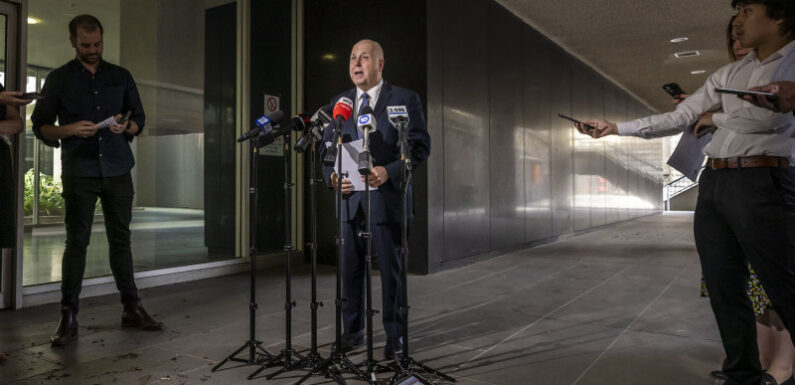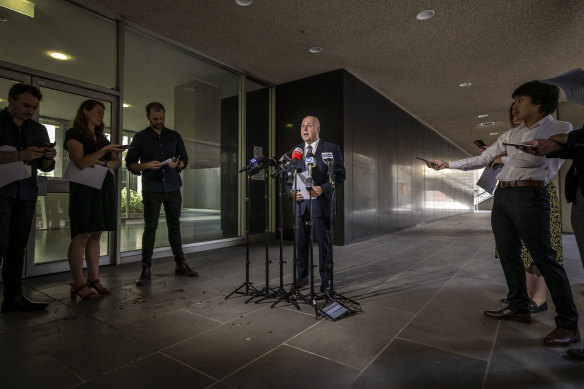
Save articles for later
Add articles to your saved list and come back to them any time.
Consumer and business gloom linked to soaring interest rates and cost-of-living pressures could add another $600 million to Victoria’s already towering debt, with Treasury warning of greater-than-normal risks to the state budget and economy.
The state government’s own economic modelling reveals that more interest rate pain could have a devastating impact on Victoria’s precarious financial position as growing numbers of households face financial stress.
Treasurer Tim Pallas releases Victoria’s budget update on Friday.Credit: Wayne Taylor
According to previous Treasury predictions, within four years, the state would be handing over the equivalent of almost $170 million a week – or $8.8 billion a year – just to meet its interest bill on debt.
But economic modelling released as an appendix to last Friday’s budget update shows an unexpected drop in consumer spending – linked to mortgage pain – could make the situation even worse, prompting businesses to wind back investment and hiring decisions, while placing downward pressure on wages growth and property and payroll tax collections.
That would probably reduce Victoria’s income by $753 million over four years compared with official budget predictions, forcing the state to rely more heavily on borrowing, resulting in a $602 million jump in net debt by mid-2027.
In a further blow, the modelling suggests a worse-than-expected consumer spending slump would delay Victoria’s return to surplus from the 2025-26 financial year to beyond the budget forecasting period, and deficits would total $600.5 million over four years.
The economic forecasts follow another blow to the state’s finance’s on Friday, when the government confirmed the cost of the North East Link had blown out to a total of $26 billion, up from the $15 billion estimated in 2019 and initial estimates of $10 billion.
Treasurer Tim Pallas said rising borrowing costs had become an issue for the budget after the Reserve Bank lifted its official cash rate 13 times since May 2022 in an aggressive push to keep a lid on inflation. The interest rate rises have totalled 4.25 percentage points.
“It’s presenting problems. It is true that in the six months to date … a very substantial part of the [increased] debt the state is carrying is also directly attributable to the movement in the cash rate,” Pallas said on Friday.
Under the new budget predictions, net debt is expected to hit $177.8 billion by mid-2027 – an equivalent of about one-quarter of the state economy. That represents an increase of $6.4 billion since the May budget, handed down just six months ago.
The proportion of revenue needed to service Victoria’s annual interest rate bill is also continuing to accelerate. The government is expecting to hand over about $8.8 billion in interest payments in 2026-27, representing about 8.6 per cent of total revenue.
That is an $800 million increase since the May budget, which predicted interest costs would be soaking up about 8 per cent of total revenue in 2026-27.
RMIT emeritus professor David Hayward, one of a small group of economists who closely monitor the state budget, said the bulk of Victoria’s debt was a result of productive infrastructure, lessening the risks of a hard landing for the budget and the state economy, particularly because interest rates were likely to begin falling.
But he said recurrent spending decisions had rapidly ramped up in the six months since the budget.
“[It is] an eye-popping amount for a budget update,” Hayward said. “This doesn’t look like a government that is pulling back to the extent that you might have expected, given inflation pressures. It still looks like a government which is pretty keen to spend, which is a little bit surprising.”
While rates are well below the levels reached in the 1990s, when they soared to 17 per cent, the figures highlight the risk that Victoria’s interest bill could soon start to weigh on other areas of recurrent spending, such as health and education, which will be needed as the population continues to soar.
Treasury warned the risks to the state’s economic outlook were greater than normal. While it said strong population growth fuelled by overseas migration could boost the economy beyond its predictions, it also warned that growing numbers of households still faced a switch from fixed to variable mortgages.
“There are many borrowers with low fixed-rate mortgages still to roll over onto much higher variable rates over coming months,” Treasury said. “This could reduce spending among these cohorts, and an increased number of households may experience financial stress.”
Far from paring back spending, government policy announcements have been increasing at an extraordinary rate.
In the six months since the budget, the government has made new recurrent spending decisions worth about $2.6 billion over four years, with more than $1 billion to hit the bottom line this financial year.
That includes $317 million over four years linked to the government’s September housing statement, $693 million for education programs, $156 million for a forestry industry transition program, and a $380 million compensation payment for the cancellation of the Commonwealth Games.
Start the day with a summary of the day’s most important and interesting stories, analysis and insights. Sign up for our Morning Edition newsletter.
Most Viewed in Politics
From our partners
Source: Read Full Article
